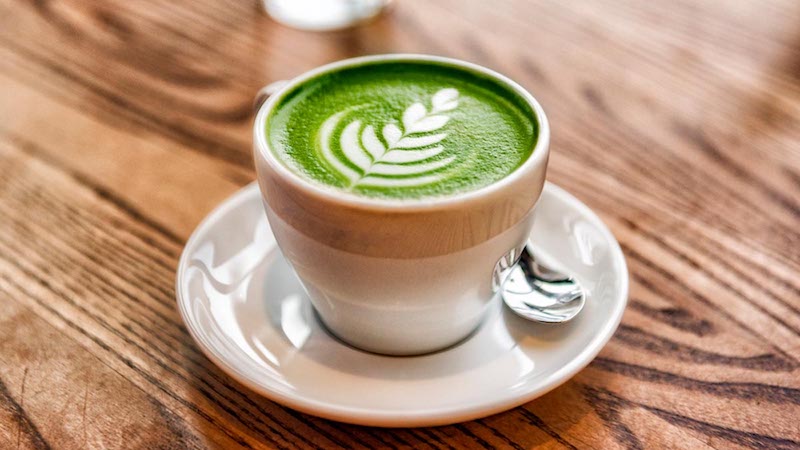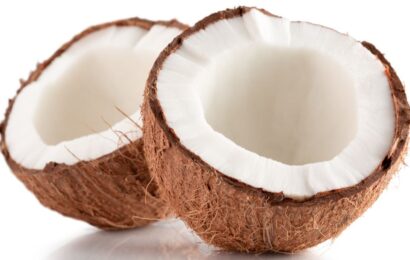If you’re a tea lover, chances are you’re familiar with matcha. Matcha is a trendy — yet ancient — beverage that looks like it’s here to stay. Not quite sure what matcha is all about? Read on to learn more about this popular drink that has taken the tea world by storm.
What is matcha, anyway?
Matcha is a powdered green tea that is made by grinding young tea leaves into a powder (matcha actually means “powdered tea”). The powder, which is a beautiful bright green color, is then whisked with hot water using a bamboo brush until it’s frothy. But, unlike regular green tea, in which the tea leaves are infused with hot water and then discarded, you’re actually drinking the tea leaves when you drink matcha.
What’s the difference between green tea and matcha?
Both green tea and matcha originate from the Camellia sinensis plant, but that’s where the similarity ends. According to the website republicoftea.com, these are “indeed two distinct beverages.” The flavor of green tea is described as light and delicate. It may have a floral, fruity, or nutty taste, depending on how it’s processed or what has been added to it. Matcha, however, has a deeper, richer flavor with a somewhat savory taste. It’s often blended with milk and sweeteners to make lattes.
Matcha is grown in select regions of Japan on plantations. The shading process of matcha begins in April, which means that the tea plants are shaded from sunlight for 30 days. This shading increases levels of theanine, an amino acid that creates a mellow and savory-sweet flavor, as well as chlorophyll, which gives matcha its distinctive green color. The darker the growing condition, the better the grade of matcha, according to the website matchaeologist.com. Matcha leaves are harvested in early May; only the youngest and greenest part of the plants are harvested, and they’re steamed for 15-20 seconds after being picked. The leaves then undergo a drying process using an air machine. Finally, the leaves are ground into a powder form using a granite stone mill, giving matcha its name “ground tea.”
Green tea, on the other hand, is grown in the sun and once harvested, the leaves are quickly heated by pan firing or steaming, and then dried to prevent them from turning brown.
To get cutting-edge diabetes news, strategies for blood glucose management, nutrition tips, healthy recipes, and more delivered straight to your inbox, sign up for our free newsletters!
What’s the history of matcha?
It’s believed that green tea originated in China during the Tang Dynasty (7th-10th century). The tea was initially prepared by roasting and pulverizing, but grinding the tea leaves started during the Song Dynasty (10th-13th century). Zen Buddhist monks prepared and drank powdered green tea as part of their rituals before they meditated to provide a sense of focus, clarity, and energy. Zen Buddhism and this method of preparing green tea were brought to Japan in 1911 by the monk Eisai, who called matcha “the elixir of the immortals.” Matcha has continued to be prominent in Japanese culture.
Today, matcha’s popularity has spread internationally, and café’ owners and tea lovers can’t seem to get enough of this vibrant tea. According to Tenzo Tea’s website, the U.S. experienced a growth of matcha-beverages by 202% in 2015. Matcha powder is not only used for tea or lattes, but also in making smoothies, cakes, ice cream, and cookies. You can even get matcha coffee! The beauty industry has also jumped on the matcha bandwagon, rolling out cleansers, face masks, lip balms, and makeup that contain matcha.
What are the health benefits of matcha?
It’s easy to get caught up in the “matcha-hype,” since it’s pretty much found everywhere these days. But from a health perspective, is matcha actually good for you? The answer: Yes! Here’s what matcha has to offer:
Catechins
Matcha contains a catechin called EGCG (epigallocatechin gallate), an antioxidant that may help fight heart disease, cancer, and type 2 diabetes; EGCG may even help to promote weight loss. Green tea also contains EGCG, but matcha contains at least three times as much.
L-theanine
This amino acid, found in matcha and other teas, is thought to promote relaxation, mood, and cognition. L-theanine may contain higher levels of L-theanine than other types of tea.
Caffeine
Caffeine is an antioxidant that has anti-inflammatory properties; when combined with the L-theanine also in matcha, there is a lesser chance of a caffeine “buzz.” Instead, the caffeine and L-theanine combo may promote a more calming type of alertness.
Low in calories and zero carbs
According to the U.S. Department of Agriculture, one cup of matcha contains only about 5 calories — of course, that’s minus any milk, cream, or sugar — making this a good choice for weight-watchers and people with diabetes alike.
Longer life expectancy (maybe!)
Tea drinkers, in general, may have a longer lifespan thanks to the heart-health benefits that tea has to offer, according to a study published in the January 2020 European Journal of Preventive Cardiology.
Is matcha good for people who have diabetes?
Based on the above benefits, people who have diabetes can certainly enjoy matcha tea as a low-calorie, no-carb beverage that also touts a handful of antioxidants. Again, adding ingredients such as cream or sugar will boost the calorie and carb content.
If you are sensitive to caffeine, don’t go overboard with matcha, especially close to bedtime. Green tea has between 20 to 39 milligrams of caffeine per 8-ounce cup. Matcha tea, made with one teaspoon of matcha powder, contains about 70 milligrams of caffeine. However, the amount of caffeine will vary depending on how much matcha you use. For comparison, an 8-ounce cup of coffee has about 95 milligrams of caffeine. Decaf matcha is also an option.
Something else to be aware of: matcha may contain lead. Lead isn’t as much of a concern with regular green tea, since the leaves are discarded. But since the whole tea leaf is used in matcha, lead contamination is possible. ConsumerLab.com estimates that matcha can contain as much as 30 times more lead than a cup of regular green tea. Choose matcha that has been tested for heavy metals. Fortunately, many of the popular matcha brands sold in the U.S. do not contain lead (or pesticides, either). These brands include Teavana Imperial Matcha, Kirkland Signature Green Tea, DoMatcha, and The Republic of Tea Double Green Matcha Tea.
How to make and use matcha
Curious about trying matcha? It’s easy to make. For both a traditional and “modern” way of preparing match, check out Pure Leaf’s instructions.
If you’re not a big fan of tea but are still interested in giving matcha a go, here are other ways to use this gorgeous green powder:
- Add a couple of teaspoons to your morning smoothie
- Sprinkle some matcha into your oatmeal
- Stir matcha into your yogurt
- Sprinkle matcha onto popcorn
- Mix matcha into your scrambled eggs
- Add it to your favorite chia pudding recipe
- Mix it into your favorite soup, stew, or stir-fry dish
- Whip up a rub for meats, poultry, and seafood using matcha, chili powder, ground ginger, dry mustard and freshly ground black pepper
Want to learn more about staying hydrated? See “Staying Hydrated,” “Best Beverages for Staying Hydrated,” “Water Facts: Getting to Know H20,” and “What’s to Drink?”





